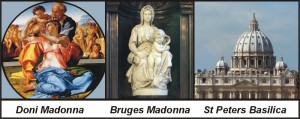Its winter, and with the snow on the ground and sub zero temperatures, marble becomes unworkable. My Marble Pieta will have to patiently wait until the spring thaw. In the off season, I turn to new projects or continue to develop older ones. Winter is the perfect time to work on maquette designs that will later be carved into stone.
Whenever I start a new piece, I’m always a little embarrassed on the difficulty I have applying the image of my imagination into anything remotely recognizable to anyone but me. If I close my eyes I can see it… but then, with pencil to paper, brush to canvas or hands to clay there is such a struggle. It takes a real leap of faith to push through this awkward phase. And this is why I always start my projects in complete isolation…. No witness to my failure. I honestly believe that any person out there can create art, if they could only get passed this initial hurtle. Art is created by the sheer will of personality.
Of course some are more talented then others… And Michelangelo was a true master… a Universal Artist.
A Master Painter, Master Sculptor, and Master Architect.
But as I pointed out in my post “The Importance of the Maquette” Michelangelo destroyed all that fell short of perfection. And we are only left with his best works; the legacy of the impossible standard.
I look to his quick sketches and wax abbreviations to remind myself that not all work needs to be finished… when starting a new project, Its best to work fast without too much concern for finished quality… Do the best that you can without loosing any sleep. Push through this awkward phase. destroy it later if you like, and no one will be wiser.
From my small bozzetto I can quickly predict structural problems, proportional issues, size limitations. I can calculate casting requirements, pouring transitions, modelling sequences. More importantly, when I squint my eyes, I can see whether the model’s shape and contours carry the intended emotional movement. Does the form and flow communicate the feelings that motivated me in the first place. For my Pieta Amare, this is the Love that we share. It’s much easier to change direction at this early stage… bending the 4 inch model one way or the other until it aligns in tune with your imagination.
Using my quick model, I will be able to scale my Maquette to within a size that will fit into the kiln… limiting the overall height to 25 inches of terrasecca clay. Or no more than 28 inches of wet clay. Pieta Amare will be a complicated assembly of separate pieces and so there is an importance to accurate measurements and calculations…
The heads and hands need to be in scale while separate from the main bodies. This will allow me to cast the plaster mould around hard to reach areas.
The body is then added around the hands and faces… this ensures that both Jesus and Mother Mary’s proportions will match. My original calculations from the bozzetto were close and with a slight twist and angle of the head, a little scraping and pulling.. my Pieta Amare should be the perfect size. You may remember from previous posts, that at this stage, only basic details are necessary… 90 percent is good enough. The final finesse can wait for the pressed clay stage.












